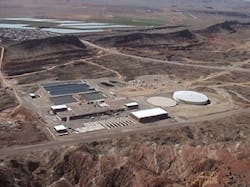OPC Drives Efficiency at Water Treatment Plant
Quail Creek Water Treatment Plant (Quail Creek WTP) is part of Washington Counties’ Water Conservancy District, a political subdivision of the State of Utah. It is a regional water supply agency organized in 1962 under the Water Conservancy Act to develop a water supply for rapidly growing areas in Utah’s Washington County. The District is primarily a wholesaler of water to other agencies. The main role of the District is to develop or purchase water where it is available for its service area. The District is committed to serving its water customers in an efficient and cost-effective manner. The District serves water on a retail basis only when other local providers are not available or do not have facilities to do so. It is dedicated to development of a resource in an environmentally sound manner.The Quail Creek Water Treatment Plant’s control system was in need of an upgrade in order to fulfill the District’s goals of efficient, cost-effective and environmentally sound operations. Phase One of the upgrade project included evolution of the existing (Siemens PLC) system to the latest control system technologies. This was performed by FMC Technologies Technisys Inc. (FMCTI), who upgraded the existing system to ABB’s System 800xA Extended Automation without any changes to the programmable logic code controller. The award-winning System 800xA from ABB, a global supplier of automation and power technologies based in Zurich, provides a better way to achieve measurable productivity and profitability improvements. It extends the scope of traditional control systems to include all automation functions in a single operations and engineering environment; enabling plants to perform smarter and better at substantial cost savings.OPC Facilitates Increased CapacityAbout two years later, FMCTI helped Quail Creek WTP with Phase Two, which increased production capacity from 20 million to 40 million gallons per day. This created several new processes and required additional PLCs. Quail Creek WTP wanted to continue to use the Siemens PLCs, but they did upgrade to newer models. ABB’s System 800xA’s capability to fully integrate the PLCs was enabled through usage of OPC 2.0 technology.The current system enables seven PLCs to talk to System 800xA. Two servers are used as a redundant pair with ten clients. There are approximately 27 control screens, providing full visibility to all key portions of the water treatment process. OPC is used to gather all data from the PLCs and display it on screens and faceplates designed in System 800xA.The Quail Creek Water Treatment Plant Staff have found it useful to use System 800xA’s document attachment feature for accessing PDF, spreadsheet and Word files from any client in the system for operational, maintenance and equipment historical purposes. The historical trending features of System 800xA have proven beneficial in forecasting operational demands and flow strategies. Learn more about ABB’s System 800xA and other process automation solutions at www.abb.com/controlsystems.

